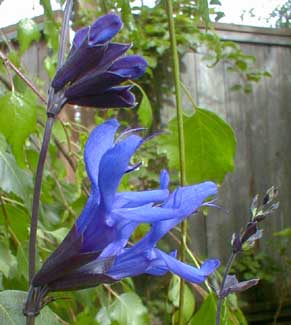
'Black & Blue'
Anise Sage
"May his leaves be healing herbs for the sick.
May much good work be done in his shadow."
-Yunus Emre
(1238-1320)
(1238-1320)
Salvia guaranitica Blue Anise Sage or Anise Scented Sage is also called Brazillian Blue Sage due to its nativity in southeastern Brazil, Paraguay & northern Argentina, or Sapphire Sage for its incredible jewel-bright blooms.
It can be sensitive to cold & can be tender in our region (Zone 8), but is right on the margin of reliably perennializing in the Pacific Northwest, returning each year, sometimes bigger & flowerier than the previous year, sometimes always seeming merely to be holding on.
In areas where winters fall below 20 degrees F., it can still do quite well as an annual. In Zone 9 or 10 it will not be sensitive, but may on the contrary require a bright shade location since its large leaves will be injured if conditions are actually deserty.
It likes moist well-draining soil, but dislikes overwatering, & can be at some risk of rotting out of the gardening during our wet winters if soil drains poorly. Ours is partially protected by eaves of the house in an area not too awfully wet in winter. In a more open area where it is subject to winter rains, a winter mulch of large-sized leaves may help barrier the soil somewhat.
It grows into a three or four feet tall, potentially a six foot semi-woody shubshrub if allowed to get lanky. Ours usually dies to the ground in winter, but sometimes it lingers in a homely sort of way & needs to be cut back to the ground in late winter or early spring.
The cultivar 'Black & Blue' has largish (one- to two-inch) tubular & open parrot-beak ("bilabiate") blossoms of cobalt blue with black calyces (where the regular species would be green). An "orniphilic" flower, the shape is intended foremost to be inviting to hummingbirds.
It takes at least until June to grow back, so some early-blooming bulbs may be nice in the same location to have their showing before the blue anise sage is renewing itself. One summer in spite of record heat, it did not make its reappearance until late July, & I'd really about given up on it; it barely gave itself time to start flowering, & just about convinced me not to plant the parrot-beak sages ever again since they start so very late & really want a much longer summer. But the blooms are just too thrilling to forgo.
These bicolor flowers can be present over a long period from mid-summer to deep into autumn, at least until first frost. Most years ours blooms July until at least November; why it delays even its foliage some years I'm uncertain but likely dependent on what the root experienced in winter.
Deadheading the spent flowers helps to keep it reblooming & at the same time taking down the stems a ways helps keep it from getting lanky. If it per chance stops blooming before summer's end, cut it back by one-third to one-half & it will take off flowering anew. The persistance of its flowering is one of its great assets, no matter how late it begins.
The attractive round pointed foliage is usually a dark even green, but occasionally a paler green. The leaves are so sweet-scented it has almost the scent of candy, hence the common name anise sage, though the scent is not really anise-like, it's more of a candied sage. It takes only a slight brushing into it in order to release its wondrous odor.
As for edibility, it is not regarded as one of the tastier sages, but a single leaf cut into small bits & sprinkled into a mixed salad would certainly add an appealing odor.
Spreading rhizomitously, over time the clump can spread to three feet wide. Large clumps can be divided in spring before new leaves begin to appear. Or starts can be made from softwood cuttings in spring (in warmer zones), or ripening summer cuttings (in our zone), or from terminal cuttings from any month it is growing.
It needs the fullest sun exposure to flower its best; it'll be much lankier & tip over if it experiences much shade, but will still bloom. A light slow-release fertilizing in early spring is enough, though some recommend monthly liquid fertilizer during its blooming period (I'd regard that as much too much, though it would require just such regular fertilizing in containers).
If soil becomes compacted over time the spreading rhizome may begin to die back to its center, so before that happens it should be dug up possibly for division, the soil well-turned for looseness & good drainage, & the clumps replanted.
Compare this species to another parrot-beak blue,
Salvia patens 'Guanajuato'